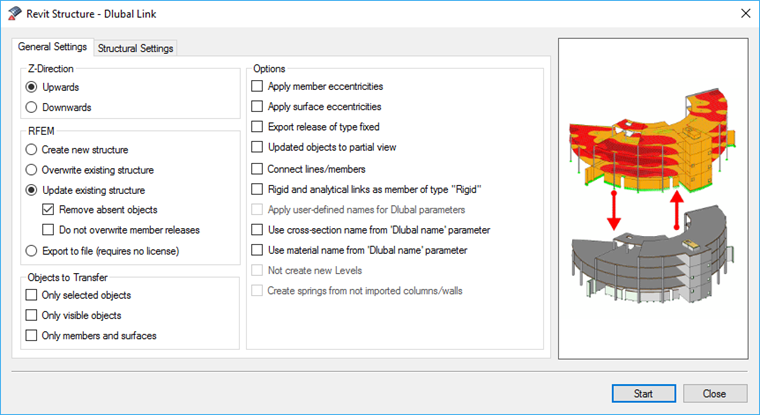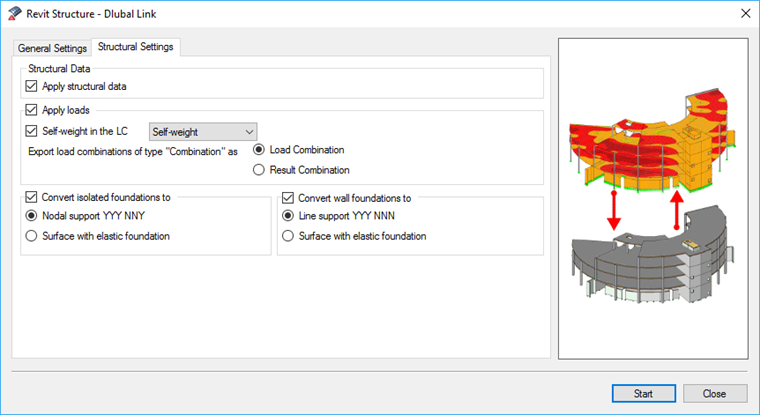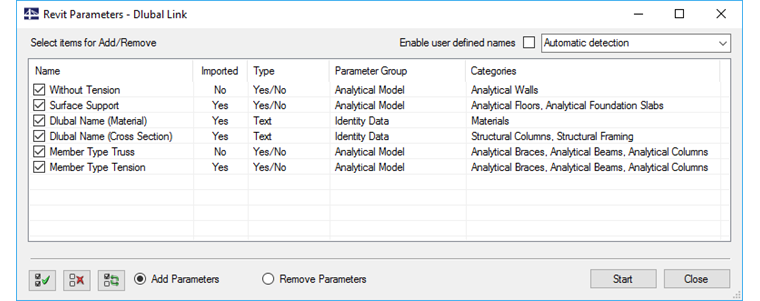General
If Revit is installed in addition to RFEM or RSTAB, the direct interface is available in Revit as a plugin. All settings for data exchange can be done in the Revit interface. Since RFEM and RSTAB are based on the object-oriented building model and Revit on the parametric building model, the objects' intelligence will not be lost when exchanging data. This means that you will get an equivalent object for every column, wall, or beam in Revit and RFEM/RSTAB, not just a collection of lines or surfaces.
Export Menu (Data Transfer from Revit to RFEM/RSTAB)
Z-Direction
Here, you define the orientation of the global Z-axis in an RFEM file. In architecture, this axis is usually oriented upwards, as a building is built from bottom to top. In structural engineering, structures are calculated from top to bottom similarly to the load transfer so the orientation of the global Z-axis is downwards.
RFEM/RSTAB
"Create new structure": It is not necessary to run RFEM/RSTAB when starting the export. The interface runs the corresponding Dlubal Software application automatically and creates a new structure with the same name as the Revit structure.
"Overwrite existing structure": The data of a model opened in RFEM/RSTAB are overwritten with the Revit data during the export. If no model is opened, the interface creates a new structure.
"Update existing structure": The existing RFEM/RSTAB data are checked during the export. New elements are added. If some components were removed in Revit after the previous export, you can also remove those objects in RFEM/RSTAB by selecting "Remove absent objects". If the model has already been adjusted in RFEM/RSTAB, you can prevent updating member end releases in RFEM/RSTAB by selecting the "Do not overwrite member releases" check box.
If a Revit user does not have an RFEM/RSTAB license, the RFEM/RSTAB data can be exported in a file using the "Export to file" option.
Objects to Transfer
The "Only selected objects" option allows you to export the objects selected in Revit to RFEM/RSTAB separately from a complex model. In Revit, it is common to work with various views. This allows you to compile the relevant components in a special view and transfer them to Dlubal Software using the "Only visible objects" option.
Options
The "Apply member/surface eccentricities" option transfers the offsets defined in Revit as member or surface eccentricities to RFEM/RSTAB.
If you select the "Export release of type fixed" option, RFEM/RSTAB creates member end releases without a degree of freedom for those members that have no releases defined in Revit.
The "Updated objects to partial view" option allows you to easily follow the modifications of a structure in RFEM/RSTAB. This option is especially useful when working with a global model.
"Connect lines/members" connects the lines or members that cross each other. This way, a mechanically connected system is generated, which can be calculated. However, this may be related to model changes which make it more difficult to align a model with Revit afterwards.
If you use the "Rigid and analytical links as member of type 'Rigid'" option, rigid members with freely definable member end releases are created in RFEM/RSTAB.
"Use cross-section/material name from 'Dlubal name' parameter": In the case of user-defined Dlubal parameters defined for the material and cross-section names, these will be used during the data exchange.
Structural Data
The data exchange can be limited to the model and/or load data. This is useful when loads are defined in a program and not supported by the other application.
Apply loads
"Self-weight in the LC": The automatic calculation of the self-weight (not possible in Revit at the moment) can be assigned to a specific load case in a Dlubal Software program.
Using "Export load combinations of type 'Combination' as", you can define whether to generate a load combination or an "enveloping" result combination. A load combination of the "casing" type in Revit is always transferred to RFEM/RSTAB as a result combination.
Convert isolated/wall foundations to
Isolated or wall foundations can optionally be converted in RFEM as hinged nodal and line supports or as surfaces with elastic foundation. In RFEM/RSTAB, there are no foundation objects as structural engineers usually use simple supports instead. Spring stiffnesses of the surfaces with elastic foundations are is preset and must be adjusted in RFEM/RSTAB.
Dlubal Parameters
Dlubal parameters allow you to provide the Revit objects with additional information so they can be then transferred to RFEM/RSTAB. Currently, the following is possible:
- Defining the "Without Tension" Dlubal element type for masonry calculation in the case of walls in Revit
- Generating surface supports in RFEM surfaces also for floor slabs in Revit
- Defining material and cross-section mapping directly for the material or cross-section in Revit
- Defining the "Truss" member type
- Defining the "Tension" member type
- Having the option of user-defined renaming of the parameter names, depending on the language
Click the [Start] button to either add or remove the parameters to the Revit project.


